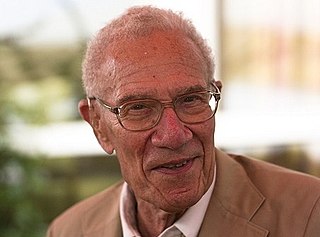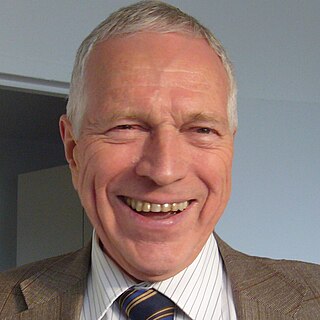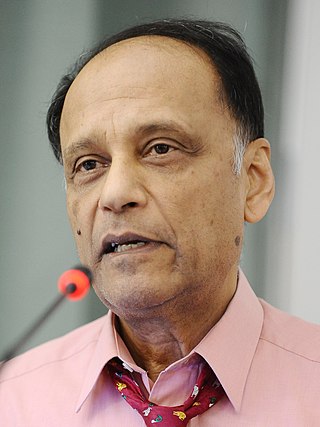Related Research Articles

Macroeconomics is a branch of economics which deals with the performance, structure, behavior, and decision-making of an economy as a whole. For example, using interest rates, taxes, and government spending to regulate an economy's growth and stability. This includes regional, national, and global economies. According to a 2018 assessment by economists Emi Nakamura and Jón Steinsson, economic "evidence regarding the consequences of different macroeconomic policies is still highly imperfect and open to serious criticism."

Economic growth can be defined as the increase or improvement in the inflation-adjusted market value of the goods and services produced by an economy in a financial year. Statisticians conventionally measure such growth as the percent rate of increase in the real gross domestic product, or real GDP.

Robert Merton Solow, GCIH is an American economist whose work on the theory of economic growth culminated in the exogenous growth model named after him. He is currently Emeritus Institute Professor of Economics at the Massachusetts Institute of Technology, where he has been a professor since 1949. He was awarded the John Bates Clark Medal in 1961, the Nobel Memorial Prize in Economic Sciences in 1987, and the Presidential Medal of Freedom in 2014. Four of his PhD students, George Akerlof, Joseph Stiglitz, Peter Diamond and William Nordhaus later received Nobel Memorial Prizes in Economic Sciences in their own right.
Consumers often choose not directly from the commodities that they purchase but from commodities they transform into goods through a household production function. It is these goods that they value. The idea was originally proposed by Gary Becker, Kelvin Lancaster, and Richard Muth in the mid-1960s. The idea was introduced simultaneously into macroeconomics in two separate papers by Jess Benhabib, Richard Rogerson, and Randall Wright (1991); and Jeremy Greenwood and Zvi Hercowitz (1991). Household production theory has been used to explain the rise in married female labor-force participation over the course of the 20th century, as the result of labor-saving appliances. More recently with the rise of the DIY or Maker movement household production has become more sophisticated. For example, consumers can now convert plastic wire into high-value products with inexpensive 3-D printers in their own homes.

Edward Christian Prescott was an American economist. He received the Nobel Memorial Prize in Economics in 2004, sharing the award with Finn E. Kydland, "for their contributions to dynamic macroeconomics: the time consistency of economic policy and the driving forces behind business cycles". This research was primarily conducted while both Kydland and Prescott were affiliated with the Graduate School of Industrial Administration at Carnegie Mellon University. According to the IDEAS/RePEc rankings, he was the 19th most widely cited economist in the world in 2013. In August 2014, Prescott was appointed an Adjunct Distinguished Economic Professor at the Australian National University (ANU) in Canberra, Australia. Prescott died of cancer on November 6, 2022, at the age of 81.

Edmund Strother Phelps is an American economist and the recipient of the 2006 Nobel Memorial Prize in Economic Sciences.
The Harrod–Domar model is a Keynesian model of economic growth. It is used in development economics to explain an economy's growth rate in terms of the level of saving and of capital. It suggests that there is no natural reason for an economy to have balanced growth. The model was developed independently by Roy F. Harrod in 1939, and Evsey Domar in 1946, although a similar model had been proposed by Gustav Cassel in 1924. The Harrod–Domar model was the precursor to the exogenous growth model.

Sir Partha Sarathi Dasgupta is an Indian-British economist who was Frank Ramsey Professor of Economics at the University of Cambridge, United Kingdom, and a fellow of St John's College, Cambridge.
Capacity utilization or capacity utilisation is the extent to which a firm or nation employs its installed productive capacity. It is the relationship between output that is produced with the installed equipment, and the potential output which could be produced with it, if capacity was fully used. The Formula is the actual output per period all over full capacity per period expressed as a percentage.
Investment-specific technological progress refers to progress that requires investment in new equipment and structures embodying the latest technology in order to realize its benefits. To model the influence of technological change upon production the influence of a technological change upon the specific inputs of a production model is assessed in terms of the resulting effect upon the final good of the model.
Dynamic stochastic general equilibrium modeling is a macroeconomic method which is often employed by monetary and fiscal authorities for policy analysis, explaining historical time-series data, as well as future forecasting purposes. DSGE econometric modelling applies general equilibrium theory and microeconomic principles in a tractable manner to postulate economic phenomena, such as economic growth and business cycles, as well as policy effects and market shocks.
Ricardo Jorge Caballero is a Chilean macroeconomist who is the Ford International Professor of Economics at the Massachusetts Institute of Technology. He also served as the Chairman of MIT's Economic Department from 2008 to 2011. He is a director of the World Economic Laboratory at MIT and an NBER Research Associate. Caballero received his PhD from MIT in 1988, and he taught at Columbia University before returning to the MIT faculty.
Greenwood–Hercowitz–Huffman preferences are a particular functional form of utility developed by Jeremy Greenwood, Zvi Hercowitz, and Gregory Huffman, in their 1988 paper Investment, Capacity Utilization, and the Real Business Cycle. It describes the macroeconomic impact of technological changes that affect the productivity of new capital goods. The paper also introduced the notions of investment-specific technological progress and capacity utilization into modern macroeconomics.

The Committee for the Sveriges Riksbank Prize in Economic Sciences in Memory of Alfred Nobel is the prize committee for the Sveriges Riksbank Prize in Economic Sciences in Memory of Alfred Nobel, and fills the same role as the Nobel Committees do for the Nobel Prizes. This means that the committee is responsible for proposing laureates for the prize. The Committee for the Prize in Economic Sciences in Memory of Alfred Nobel is appointed by the Royal Swedish Academy of Sciences. It usually consists of Swedish professors of economics or related subjects who are members of the academy, although the academy in principle could appoint anyone to the committee. Two of the members of the founding committee as well as later members of the committee had also been associated with the Mont Pelerin Society.

Real business-cycle theory is a class of new classical macroeconomics models in which business-cycle fluctuations are accounted for by real shocks. Unlike other leading theories of the business cycle, RBC theory sees business cycle fluctuations as the efficient response to exogenous changes in the real economic environment. That is, the level of national output necessarily maximizes expected utility, and governments should therefore concentrate on long-run structural policy changes and not intervene through discretionary fiscal or monetary policy designed to actively smooth out economic short-term fluctuations.
Karl Gunnar Persson was a Swedish economic historian whose contribution lies mainly in comparative European economic history.
Zvi Eckstein is a full professor, dean, Arison School of Business and Tiomkin School of Economics at The Interdisciplinary Center Herzliya - IDC. Emeritus Professor at the Eitan Berglas School of Economics, Tel Aviv University. Head, the Aaron Economic Policy Institute, IDC, Herzliya. University of Pennsylvania, the Wharton School, Finance Department, Judith C. and William G. Bollinger Visiting Professor Served as deputy governor, Bank of Israel (2006-2011). The Walras-Bowely Lecturer, the Econometric Society, North America Summer Meetings, Pittsburgh, US, June 19, 2008. Fellow of the Econometric Society.
Michèle Tertilt is a German professor of economics at the University of Mannheim. Before, Tertilt was an assistant professor at Stanford University. She also spent a year at the University of Pennsylvania and one year as a research fellow at the Hoover Institution. She is currently a director of the Review of Economic Studies and associate editor of the Journal of Development Economics. In 2017 she received the Yrjö Jahnsson Award – a biennial award by the European Economic Association and the Yrjö Jahnsson Foundation to a European economist no older than 45 years, who has made a contribution in theoretical and applied research that is significant to economics in Europe. In September 2013 she was awarded the Gossen Prize – an annual award by the Verein für Socialpolitik which recognizes the best published economist under 45 working in the German-speaking area. Tertilt is the first woman to win this prestigious German prize in economics. In 2019, she was awarded the Gottfried Wilhelm Leibniz Prize by the Deutsche Forschungsgemeinschaft. Her main focus is around development and intra-family interactions. She has also worked on consumer credit and bankruptcies.
Carol A. Corrado is an American economist who was the former chief of industrial output at the Federal Reserve Board and currently serves as a senior advisor and research director in economics on The Conference Board. She serves as a member of the executive committee for the National Bureau of Economic Research's (NBER) conference on research on income and wealth. She is a senior policy scholar at Georgetown University McDonough School of Business Centre for Business and Public Policy where she focuses on economics of growth and innovation as well as fiscal and monetary policies. In addition to these positions, Corrado is involved with the American Statistical Association as well as the Technical Advisory Committee of the Bureau of Labor Statistics. With the American Statistical Association Corrado serves as the chair-elect of Business and Economics.
Zvi Hercowitz is professor emeritus at Tel Aviv University's School of Economics and has been a member of the montetary committee of the Bank of Israel since 2017.
References
- ↑ Per Krusell and Anthony A. Smith, Jr., (1998), 'Income and wealth heterogeneity in the macroeconomy'. Journal of Political Economy 106 (5), pp. 867-96.
- ↑ Jeremy Greenwood, Per Krusell and Zvi Hercowitz, (1997), 'Long-Run Implications of Investment-Specific Technological Change'. American Economic Review 87 (3), pp. 342-62.
- ↑ "Past Presidents | EEA". www.eeassoc.org. Retrieved 2021-01-07.
- ↑ Some history for this research is here: http://hdl.handle.net/1802/2375